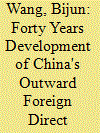|
|
|
Sort Order |
|
|
|
Items / Page
|
|
|
|
|
|
|
| Srl | Item |
| 1 |
ID:
106008


|
|
|
|
|
| Publication |
2011.
|
| Summary/Abstract |
Chinese outward direct investment (ODI) appears to differ from that of advanced economies. Is there a unique China model? By reviewing industry distributions of ODI data for 2003-2009, we found that Chinese ODI was not concentrated in industries that performed well either in exporting or domestically. Statistical analyses also confirmed that traditional variables, such as market size, production cost and legal environment, did not impact Chinese investors' choice of location for ODI. Instead, investors selected places where they could either learn advanced technologies or secure stable commodity supplies. We have tentatively concluded that the main purpose of the China model of ODI has not been to expand production overseas but to strengthen industries at home.
|
|
|
|
|
|
|
|
|
|
|
|
|
|
|
|
| 2 |
ID:
097822


|
|
|
|
|
| Publication |
2010.
|
| Summary/Abstract |
This paper attempts to explain the fundamental cause of China's growing imbalance problems. Economic data confirm that the key structural imbalance problems, such as overinvestment, large current account surpluses, low consumption share of GDP and income inequality, have all deteriorated over the past few years, despite continuous policy efforts to correct these problems. We argue that the key determining factor is repressed factor cost, which is associated with heavily distorted markets for labor, capital, land, resources and the environment. These are like implicit subsidies for producers, investors and exporters. They boost growth and, at the same time, lift investment and exports. Previous policy efforts have focused more on administrative measures, which have not been sustainable. Therefore, a more fundamental solution to the imbalance problem lies in completing market-oriented reforms for production factors and allowing free markets to determine prices of labor, capital, land and resources.
|
|
|
|
|
|
|
|
|
|
|
|
|
|
|
|
| 3 |
ID:
167884


|
|
|
|
|
| Summary/Abstract |
Outward foreign direct investment (OFDI) has increasingly become an important method for China to integrate into the world economy. This paper comprehensively reviews and analyzes policy development and the changing pattern of China's OFDI over the past 40 years. We divide the development into “restricted” (1978–1999), “relaxed” (2000–2016) and “regulated” (2017 onwards) stages. This paper also reviews literature on the impact of Chinese OFDI on China and host countries. Despite its generally positive effects, large‐scale and unbalanced OFDI activities have alarmed Chinese policymakers. Both developing and developed host countries have expressed their concern over national security and the misbehavior of some Chinese overseas enterprises. Therefore, greater supervision and adjustment from quantity to quality growth is necessary for the future development of China's OFDI.
|
|
|
|
|
|
|
|
|
|
|
|
|
|
|
|
| 4 |
ID:
121740


|
|
|
|
|
| Publication |
2013.
|
| Summary/Abstract |
Economists have put forward various proposals to deal with the growing risks of the global reserve currency system. In this paper we recommend that Asian economies hold each other's currencies as part of their foreign reserves. Different from crisis-fighting currency swap arrangements or crisis-rescuing fund mechanisms, this mechanism means that reserves would be held, with a regular arrangement in place and on an ongoing basis. We propose that the global reserve system should be pushed in the direction of diversification, which could be a transitional step toward a new single reserve system. This mechanism would not necessitate any currency being a globally accepted reserve currency but would mean that every currency carried some weight in the reserve system. Establishment of such a system would require significant development of regional bond markets and facilitation of macroeconomic surveillance among the economies.
|
|
|
|
|
|
|
|
|
|
|
|
|
|
|
|
|
|
|
|
|